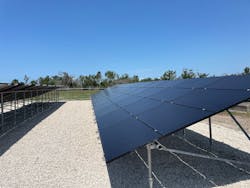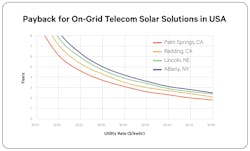It might come as a surprise to many—including some in the US telecommunications industry—that solar power has been a common, essential part of many telecom networks for more than a decade. In many parts of the world, hybrid power systems relying on solar power to supplement unreliable or expensive utility power or off-grid generators are a way of life. In the US, where a reliable grid is readily available and the cost of electricity low, there simply wasn’t a business need for those same hybrid systems.
Well, the times, as Bob Dylan famously mumbled, they are a-changin’.
To be clear, solar deployments aren’t yet common, but there is an upward trajectory as telecom providers respond to changing market conditions and network demand.
These deployments fall into one of two categories. The first is original and will be familiar to anyone who has worked in telecommunications in Africa for the past 15 years. These are off-grid deployments in remote locations the grid doesn’t reach. In these configurations, solar power supplements or replaces the on-site diesel generators to minimize fuel runs and, secondarily, carbon emissions. As there aren’t many places in the US without access to utility power—and even fewer with a climate suitable to solar in winter—these types of deployments tend to be one-offs with few implications for long-term strategy.
The other type is more interesting and telling. These are intentional, strategic deployments to grid-supported sites, and they’re increasingly common in states with high electricity costs and/or a history of unreliable grid performance. This trend is significant not for the scale of adoption, which remains relatively limited in first world nations, but for what it represents—the first meaningful foray into solar power for telecom networks in the US. It’s part of a larger effort across the industry to manage surging energy consumption and costs.
The Consumption Challenge
Population growth and an increase in the number of connected people and devices—along with the compute-heavy apps proliferating across those devices—ensure telecom’s already sizable share of global energy consumption will continue to grow. Telcos are responsible for an estimated 2-3% of global energy use1 and 1.4% of carbon emissions2, and 5G is expected to double or even triple the industry’s consumption over the next decade3.The focus of telecom operators has been firmly on network upgrades and expansion, but these numbers can’t be ignored—nor are they.
Make no mistake, today’s telcos are expanding and upgrading their networks as fast as technology, the workforce and financial resources will allow, but they’re increasingly aware of the operational costs of those networks and developing strategies to manage those costs.
Solar and the Search for “Free” Energy
Before we dive too deeply into solar or any other energy-, carbon- or cost-cutting measure, let’s acknowledge one absolute truth: geographies and climate are different, grid reliability and water availability vary regionally and fluctuate over time—as do real estate availability and costs—and government and industry regulations differ and evolve. The telecom landscape is endlessly complicated, and no single strategy is sure to be right for every site.
Having said all that, the search for ways to reduce costs associated with grid power and the associated carbon footprint is leading naturally to the evaluation of alternative energy sources. As the most common and scalable option, solar has emerged as the preferred choice for most applications—including in the US.
Hybrid energy systems using solar power are commonplace in much of Africa, the Middle East, parts of Asia, and increasingly in Europe. Deployments are accelerating as the prices of solar4 and utility power in many markets inch closer to intersection, making solar a cost-effective5, reliable supplement.
The US and Canada (and until recently Europe) have long been outliers, comfortable with reliable, affordable utility power across most of the country. That’s changing in certain states, however, with demand for electricity at time exceeding capacity and that same supply and demand calculus driving prices to levels that make solar not just viable, but attractive. The payback for an on-grid solar deployment at a given site depends on many factors, including the amount of sunlight the site receives. Still, broadly speaking, when prices reach $0.25/kWh, the return on investment (ROI) drops to the 4-5-year range. If prices go higher, the ROI drops further. Most of the US is comfortably under that $0.25/kWh threshold, but Hawaii, California, New York, New Hampshire, and a few other states routinely exceed that number, bringing solar into the conversation and paybacks typically in the 2-4-year range. (See Figure 1.)
There’s a lot to like about on-grid solar. It reduces the operating cost of utility power. During power outages, it can reduce battery discharges, which extends battery life spans. It reduces reliance on generators and the carbon emissions those generators produce. Solar arrays at telco sites typically are installed above existing equipment, providing shade and reducing cooling costs and slowing the drain the sun extracts on batteries.
There are compelling reasons the rest of the world has already embraced solar power in the telecom access space, and market conditions are shifting to make a convincing case for US operators.
Low-Hanging Fruit
Solar is an interesting emerging opportunity in the US and Canada, but there are other ways telcos can manage their energy use and carbon footprint. Some of these are obvious and widely—but not universally—adopted. For example, transitioning to high-efficiency rectifiers and DC power systems can improve energy efficiency by 5-6%6, but legacy deployments remain in virtually every network. Energy-saving modes and features common to modern equipment are ignored habitually in favor of static operation.
Operators addressing the issues more aggressively should consider widespread deployment of Lithium-ion (Li-ion) batteries at access sites. Li-ion batteries have higher power densities than lead acid, last longer, and can operate at higher temperatures, reducing the energy required for cooling. Battery management systems are mandatory with Li-ion, helping organizations leverage the technological sophistication and full range of features built into these smart batteries. Longer lasting, more reliable batteries enabled with machine-to-machine communications will reduce truck rolls and costs and reduce the carbon emissions associated with those activities.
The opportunity by introducing cyclic Li-ion batteries also makes it possible for telcos to engage in peak shifting and shaving and similar energy management strategies. These can be used to counter Time of Use and Demand Pricing policies that more and more utility providers are adopting in an effort to manage supply and demand. Peak shifting (in response to Time of Use pricing) and peak shaving (for Demand Pricing) are less common at on-grid sites today, but that is likely to change as Time of Use and Demand Pricing become the norm and Li-ion batteries are more widely deployed. As lithium batteries age gracefully, and quickly recharge, reducing the risk of shifting load to the batteries and making them a good option for creative load management on- or off-grid.
“Telcos are responsible for an estimated 2-3% of global energy use and 1.4% of carbon emissions, and 5G is expected to double or even triple the industry’s consumption over the next decade. The focus of telecom operators has been firmly on network upgrades and expansion, but these numbers can’t be ignored—nor are they.”
The Bottom Line
There is no single answer to the energy and emissions challenges facing today’s telecom providers, but strategies exist and are emerging that can help operators manage their consumption and carbon footprint. Deploying more efficient equipment and engaging high-efficiency operating modes are an important first step, but real change will require more ambitious steps. Deploying Li-ion batteries and leveraging their capabilities to expand what support energy storage can do is one such example. More widespread adoption of on-grid solar power in states with higher electricity prices and plentiful sunlight offers greater promise, and activity on this front in parts of the US is encouraging.
Ultimately, the telecom carriers alone will be unable to fully mitigate the power demands of expanding and evolving telecom and data networks, but they can and should work to mitigate their impact. Meanwhile, the societal advances telcos are enabling will continue to contribute to a holistic, global effort to combat climate change.
REFERENCES AND NOTES
1. https://www.businesswire.com/news/home/20210209005153/en/Guidehouse-Insights-Report-Finds-Telecom-Networks-Are-Expected-to-Install-122-GW-of-New-Distributed-Generation-and-Distributed-Energy-Storage-Capacity-from-2021-2030
2. https://www.ericsson.com/en/reports-and-papers/research-papers/the-future-carbon-footprint-of-the-ict-and-em-sectors
3. https://www.businesswire.com/news/home/20210209005153/en/Guidehouse-Insights-Report-Finds-Telecom-Networks-Are-Expected-to-Install-122-GW-of-New-Distributed-Generation-and-Distributed-Energy-Storage-Capacity-from-2021-2030
4. https://www.nrel.gov/news/program/2021/documenting-a-decade-of-cost-declines-for-pv-systems.html
5. https://www.vertiv.com/493d09/globalassets/products/critical-power/dc-power-systems/white-paper---when-can-we-afford-to-deploy-solar-.pdf
6. https://www.vertiv.com/en-emea/campaigns/dc-power-efficiency/
About the Author

David Wilson
Global Offering Director for Solar and Telecom Energy Solutions in the DC Power Line of Business, Vertiv
David Wilson is Global Offering Director for Solar and Telecom Energy Solutions in the DC Power Line of Business at Vertiv. As a technical engineer with nearly 40 years of experience, David has supported the development of computer hardware, software, and telecom application layers. He is currently focused on deploying sustainable network infrastructure solutions across the globe.
For more information, visit https://www.vertiv.com/en-us/. Follow Vertiv on Twitter @Vertiv, LinkedIn: https://www.linkedin.com/company/vertiv/, and Facebook: https://www.facebook.com/vertiv.

